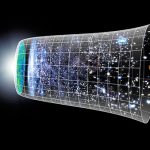The Mysterious Clumping Universe
The Mysterious Clumping Universe
If you’re an astrophysicist, you might look at the above image and ask yourself how these nearby galaxies are distributed. Are they regularly distributed? Randomly distributed? Clumped together?
Each of these means something different. Regular means, if I drew a 3-D grid in space, each box would have roughly one galaxy in it. Random is what you’d get if you blindfolded yourself and placed down points, completely at random. And clumped is what you’d get if the galaxies preferentially clustered around a few points, and away from certain others.
And as you can tell with a simple, visual inspection, the galaxies are definitely clumped or clustered together in the Universe. But this is troubling, and it should be troubling! Because initially, the Universe started off extremely uniform. And if we want to measure the departuresin space from uniformity, we can do so when the Universe was only about 0.0028% of its current age!
These fluctuations are random, not clumped.
So, you may ask yourself, “Well, how did I get here?”
Did you answer “gravity”? Gravitational collapse is a huge part of it. But that will only get you the qualitatively correct answer.
In other words, you’ll get something that’s clumped together instead of random. But we can go further, and ask, “What does it take to get the right amount of clumping?”
If all you had was normal matter — protons, neutrons, and electrons — then when they tried to collapse, the photons (radiation) in the early Universe would push back on them, and there would be certain scales that structure was completely suppressed on.
And that doesn’t happen.
But if all you had in your Universe was dark matter, you’d just get these big, diffuse halos of dark matter, with no galaxies at all. Moreover, if you want to get small halos in addition to large ones, you need your dark matter to be cold, or at a lower temperature (moving at a slower speed).
The structure we make in the Universe is very sensitive to the mixture of normal matter, dark matter, and photons that we have. Too much normal matter, and the “wiggles” in the above diagram are too large. Too much dark matter, and the wiggles disappear. And if the dark matter is too hot, the graph gets truncated on the right-hand side. So when we go to the data, what do we learn?
We learn how much normal matter (i.e., atoms), radiation, dark matter, and (even) dark energy are in the Universe! You change any of these ratios by even a few percent, and the Universe would look entirely different.
What’s remarkable is that the numbers we get — looking at this large-scale structure in the Universe — are the same numbers we get for the amount of dark matter, dark energy, and normal matter in the Universe from looking at the cosmic microwave background or at supernovae!
This is one of the most compelling arguments for our story of dark matter in the Universe, with no other explanation coming even close to reproducing the predictions of dark matter.
So you may ask yourself, “How did I get here?” And the answer is that dark matter and dark energy brought all of it — the paltry 4.6% of the Universe that is you, the Earth, and all the stars and galaxies in the Universe — here.
Beautiful, isn’t it? Thank God.



